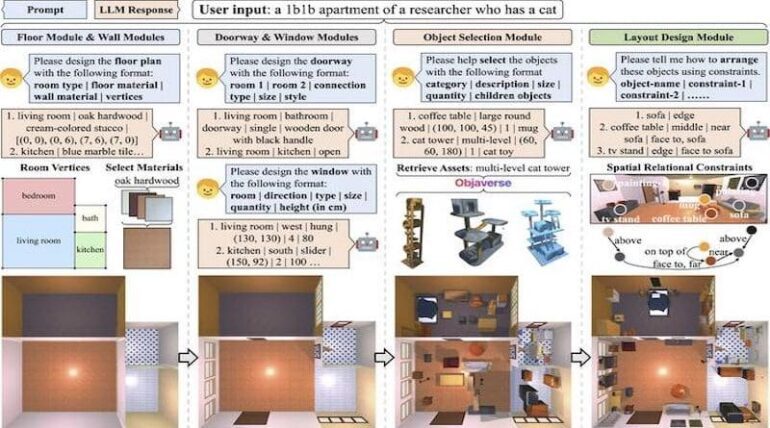- Penn engineers developed Holodeck, inspired by Star Trek’s concept, to create virtual 3D environments using natural language commands.
- The system leverages advanced AI technology and large language models to generate diverse and realistic simulations for training AI systems.
- Holodeck outperforms traditional methods in terms of realism, coherence, and user preference, as validated by blind tests involving engineering students.
- It demonstrates versatility by generating various indoor environments beyond residential spaces, enhancing AI agents’ performance in tasks like object recognition and spatial navigation.
Main AI News:
In the iconic Star Trek series, the holodeck served as a versatile tool for the crew of the USS Enterprise, offering immersive 3D simulations of any environment imaginable. Now, researchers at the University of Pennsylvania’s School of Engineering and Applied Science are bringing this futuristic concept to life with their groundbreaking system, Holodeck.
Developed by a team led by Mark Yatskar and Chris Callison-Burch, along with collaborators from Stanford, the University of Washington, and the Allen Institute for Artificial Intelligence (AI2), Holodeck is a cutting-edge platform that leverages advanced AI technology to generate interactive 3D environments. Inspired by its namesake from Star Trek, Holodeck empowers users to effortlessly create and customize virtual spaces using natural language commands.
One of the key challenges in training AI systems for real-world applications is the scarcity of diverse and realistic training environments. Traditional methods rely on manual creation, which is time-consuming and limits scalability. Holodeck addresses this issue by enabling the rapid generation of a wide range of indoor environments, from residential apartments to commercial spaces, using AI-driven algorithms.
The system harnesses the power of large language models (LLMs), such as ChatGPT, to interpret user requests and generate detailed environments with remarkable accuracy. By engaging in a conversational dialogue with the user, Holodeck breaks down complex commands into specific parameters, seamlessly translating language into virtual reality.
To validate the effectiveness of Holodeck, the researchers conducted extensive evaluations comparing its output with that of existing tools. In blind tests involving hundreds of engineering students, Holodeck consistently outperformed previous methods in terms of realism, coherence, and overall preference.
Furthermore, Holodeck demonstrated its versatility by successfully generating diverse environments beyond traditional residential spaces. From retail stores to public venues, the system showcased its ability to create realistic simulations of various indoor settings, surpassing the capabilities of manual creation methods.
Perhaps most impressively, Holodeck proved instrumental in enhancing the performance of embodied AI agents, enabling them to navigate and interact with virtual environments more effectively. By fine-tuning AI agents using scenes generated by Holodeck, the researchers achieved significant improvements in tasks such as object recognition and spatial navigation.
As the field of robotics continues to advance, Holodeck represents a major step forward in the development of AI-driven training environments. With its ability to rapidly generate diverse and realistic simulations, this innovative platform has the potential to revolutionize AI research and application across a wide range of industries.
In the words of Yue Yang, a doctoral student involved in the project, “Holodeck provides the functionality to efficiently generate a multitude of environments for training robots, unlocking new possibilities for AI-driven innovation.”
Conclusion:
Penn Engineers’ Holodeck represents a significant advancement in AI-driven training environments, offering a scalable solution for creating diverse and realistic simulations. This innovation has the potential to revolutionize AI research and application across multiple industries, unlocking new possibilities for AI-driven innovation and market growth.

